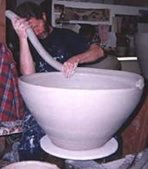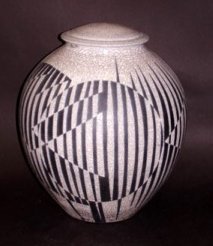|
Handmade Pottery
|
| History of Pottery | Pottery Tools and Supplies |
| Pottery Wheel | Coil Pottery |
| Pottery Glazes | Pottery Firing |
| Raku Pottery | Horse Hair Pottery |
| Pottery Repairs | Pottery Marks |
Overview
Handmade Pottery typically refers to Ceramics including art objects such as figures, tiles, and tableware made from clay and other raw materials by the process of forming and firing. This category generally excludes glass and mosaics made from glass.
Ceramics encompass several sub-categories including:
- Structural – includes bricks, pipes, floor, and roof tiles
- Refractories – includes kiln linings, gas fire radiants, steel and glass making crucibles
- Technical (or engineering) – includes tile used with the Space shuttle, nuclear fuel pellets, and many other examples.
- Whitewares – includes tableware, wall tiles, pottery items, and sanitary ware
Whiteware Ceramics is where we will focus
Whitewares are often broken down into:
- Earthenware – usually made from clay, quartz, and feldspar
- Stoneware – a man-made hard and dense stone
- Porcelain – White glassy (vitreous) compound primarily made of kaolin
- Bone China – Type of porcelain which also includes cattle bone ash
Earthenware is a very common ceramic and is usually the base product for pottery tableware and decorative items. Earthenware, is one of the oldest materials used in handmade pottery and is generally composed of:
- 32% Quartz
- 28% Kaolin
- 25% Ball clay
- 15% Feldspar
Earthenware is commonly
- Bisque fired (heated prior to glazing) between 1800 and 2100 degrees F (1000 – 1150 degrees C), and
- Glost fired (heated after glaze application) to 1750 – 1925 degrees F (950 – 1050 degrees C).
However, some potters for special affects, choose to reverse these typical firing temperatures. We’ll talk more about this on our How to Make Pottery page.
Stoneware
Stoneware is basically a man-made stone. It is dense, impermeable, and hard enough to resist scratching by sharp steel. It is different from porcelain in that it is more opaque, and typically only partially vitrified (glassy). It is often colored gray or brownish due to impurities and usually finished with glaze.
Its maturation temperature is typically between 2192 – 2399 degrees F. (1200 – 1315 degrees C). By contrast, earthenware is typically fired at lower temperatures and is not impervious to liquids.
Note: Maturation is the point at which clay or glaze reach their optimal state.
-For Clay, it is a balance between a tight, hard, vitreous form and deformed body.
-For Glaze, it is the balancing point between a tight, hard, vitreous coating and a "running off the pot", and melting into a puddle on the shelf of the kiln.
Porcelain
Considered by some to be a type of stoneware, Porcelain is usually whiter than stoneware, and is always vitreous (glass like). Porcelain is a ceramic material generally made by heating clay in the form of kaolin in a kiln to temperatures between 2192 – 2552 degrees F. (1,200 –1400 degrees C). The strength and translucent appearance of porcelain is mainly due to the formation of glass and the mineral mullite, a result of firing at these high temperatures. Rocks that are rich in kaolinite are known as china clay, white clay, or kaolin.
Bone China
Bone China is a type of porcelain that contains cattle bone. Bone china is typically very white, translucent, and very strong.Typically bone china is made by firing first without glaze (bisque firing) at a high temperature around 2336 degrees F (1280 C) which gives the translucent look. Then it is fired after glaze is applied at the lower temperature of approximately 1976 degrees F (1080 C).
History of Handmade Pottery
What – 29,000 years ago? Wow that is some old Pottery.
Yes, archaeologists have uncovered the oldest fired clay figurines dating back to 29,000 BC.
And what about that potter’s wheel, kilns, and glazes, where did they originate? Check out our page on The History of Pottery and your eyes will be opened to these handmade pottery questions and more ... like how did the Raku process get started. And no, I’m not talking about the spaghetti sauce!
And what about the Piggy Bank –
Where did the name Piggy Bank originate?
Check out all the answers to these questions and more at our
History of Pottery page.
Pottery Supplies and Tools
The Potter’s primary tools are their hands. However, through the long history of pottery making, many other tools have been developed including:
- The Pottery Wheel and turntable,
- Shaping tools (paddles, anvils, ribs),
- Rolling tools (roulettes, slab rollers, rolling pins)
- Cutting/piercing tools (knives, fluting tools, wires) and
- Finishing tools (burnishing stones, rasps, chamois).
- Kiln for firing the pottery. Kilns come with several heat sources including:
- Gas fired
- Electric
- Wood burning
- Microwave assisted
And every Artist and Craftsman needs appropriate Craft Storage equipment. Checkout some suggestions here on our Craft Storage page.
The Pottery Wheel
Wheel-work makes great demands on the skills of the pottery artist. However an accomplished potter can make many near-identical plates, vases, or bowls in the course of a day's work using the pottery wheel.In the process known as “throwing” the Potter places a ball of clay in the center of the potter’s wheel (the wheel head).
Why is it called "Throwing" pottery?
You'll find the answer to this question as well as tricks of the trade, and see videos of our favorite Pottery Artists in action on our Pottery Wheel page.

Coil Pottery
One popular technique of making handmade pottery is using the coil method. Coil pottery dates back to the ancient Greeks thousands of years go. Slabs of clay are rolled out into long ropes, then coiled around and pinched to fuse with the coils above and below.
Some of the largest clay creations use the Coil Pottery method.

For more information, 'how to' and pictures on this age old method of pottery making, check out the Coil Pottery page.
Pottery Glazes
The word Glaze actually comes from the the root word "glaer" which is the same root for Glass. Glaer referred to amber, the fossil resin that is translucent and yellowish in appearance. You see glazes are actually a pottery coating that once heated (fired) at the appropriate temperature, melts, then cools, then forms a glass like coating on the pottery.
Glazes typically are made up of 5 components: Silica, Alumina, Flux, Colorant, and Modifiers. We discuss what these are and more on our Pottery Glazes page.
Firing
We don't consider it "Pottery" unless it has been "fired" (If we did, then We might get 'fired').
Ok, ok already, let's get serious here.
Firing is when green (unfired) ceramic forms are heated to high temperatures in a kiln to permanently set their shapes. Firing makes irreversible changes in the clay body, as well as the applied glaze. Typically handmade pottery is fired twice:
- Bisque fired - after the form is made but before glaze is applied, then
- Glost fired - after bisque firing and after the glaze has been applied.
Earthenware pottery is often bisque fired at temperatures ranging from 1800 to 2100 degrees F (1000 to 1150 degrees C). And Glost fired at a cooler 1750 to 1925 degrees F (950 to 1050 degrees C)
Porcelain is fired at a higher temperature than earthenware so that the body can vitrify and become non-porous. Porcelain is typically fired at temperature ranges of 2192 to 2552 degrees F (1200 to 1400 degrees C). After firing, porcelain becomes very tough, strong, typically white, impermeable (even without glaze) and translucent primarily due to the mineral mullite that exists within the porcelain clay.
Raku
Raku is a process in which work is removed from the kiln when it is at a bright red state then it is placed in a container of combustible material, like newspaper, wood chips, or other. This "reduction" or smoking phase, causes blackening and crazing (a network of fine cracks) in the glaze surface. One of our favorite Raku Pottery Artists, Deborah Slahta creates some beautiful Raku pottery like this vase. See Deborah's work here.Horse Hair Pottery
A beautiful and unique pottery decorating technique uses horse hair, as well as other animal hairs. When placed on the hot fired raku form, these carbon based materials will leave an ash adhering to the clay.
Get the scoop on Horse Hair Pottery.
Pottery Repairs
And hopefully your beautiful handmade pottery remains in great condition, and never suffers a crack, break, chip, or other condition. However, if it does, there is some hope. First let me say, that if the item is of great sentimental or financial value, see a professional antique restorer. Sometimes handmade pottery repair attempts by an amateur can actually damage the piece further. So assess the situation and be smart about it.
If it is not of great sentimental or financial value, you can probably fix it. We provide some how to repair advice on our
Pottery Repair page.
And if it's a China or Porcelain Repair you're interested in, you can find that right here on our
China Pottery Repair - Porcelain Pottery Repair page.
Pottery Marks
Now this is a big topic. We cover the various handmade American pottery marks established by the active pottery manufacturers of the 1800's and 1900's.
Take a walk through the history of early American Pottery manufacturing and peruse the 200 plus Pottery Marks.
Only put off until tomorrow what you are willing to die having left undone.
Appreciate when you ...
What's New on BH?
Blog: Old Fourth Ward - Atlanta, GA
Feature: Potter - Julie Jones
Store: Paintings by Carol Benner
Editor Picks from Store

|

|

|
| Lavender Painted Soap | Volcano Dangle Earrings | Footed Coffee Mug |




